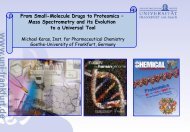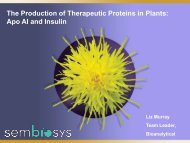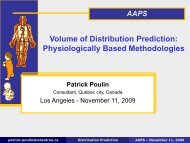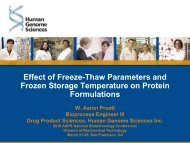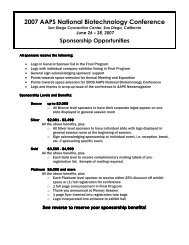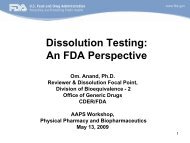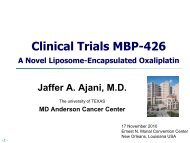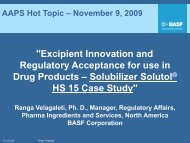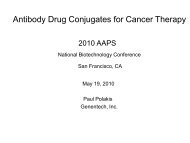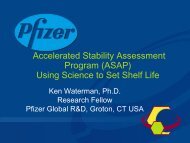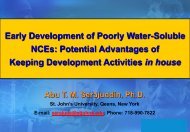Preliminary Program - American Association of Pharmaceutical ...
Preliminary Program - American Association of Pharmaceutical ...
Preliminary Program - American Association of Pharmaceutical ...
Create successful ePaper yourself
Turn your PDF publications into a flip-book with our unique Google optimized e-Paper software.
70<br />
2009 AAPS Annual Meeting and Exposition<br />
AAPS Pharmacokinetics, Pharmacodynamics and Drug Metabolism (PPDM) <strong>Program</strong>ming<br />
Moderators<br />
Tycho Heimbach, Ph.D., M.S.<br />
Novartis<br />
Jennifer J. Sheng, Ph.D.<br />
AstraZeneca<br />
Minimizing the Guesswork <strong>of</strong> Early Human<br />
Dose Predictions: Application <strong>of</strong> PK Prediction<br />
Methodologies Including PBPK (Part 1)<br />
Steven C. Sutton, Ph.D., R.Ph.<br />
Simulation Consultation Services<br />
Minimizing the Guesswork <strong>of</strong> Early Human<br />
Dose Predictions: Application <strong>of</strong> PK Prediction<br />
Methodologies Including PBPK (Part 2)<br />
Natilie Hosea, Ph.D.<br />
Pfizer, Inc.<br />
7:00 am – 8:15 am<br />
Today, Tomorrow, and Beyond:<br />
Approaches and Challenges in Modeling<br />
Pharmacodynamic Effects with Long<br />
Time Delays<br />
Sunrise Session<br />
This session will provide a comprehensive summary<br />
<strong>of</strong> empirical, semi-mechanistic, and mechanistic<br />
approaches for modeling long time delays in<br />
exposure-response relationships and discuss their<br />
advantages and limitations. Modeling & simulation<br />
activities are widely applied in various stages <strong>of</strong> drug<br />
development, and quantitative model-based drug<br />
development is strongly promoted by U.S. Food and<br />
Drug Administration (FDA) and many pharmaceutical<br />
companies. Establishment <strong>of</strong> exposure-response<br />
relationships and their prospective application<br />
in drug development is <strong>of</strong>tentimes hampered by<br />
long time delays between drug concentration-time<br />
pr<strong>of</strong>iles and effect-time pr<strong>of</strong>iles in the order <strong>of</strong><br />
days, weeks or even months. The development <strong>of</strong><br />
small molecule NCEs as well as biologics may be<br />
complicated by these time delays between exposure<br />
and response. Examples <strong>of</strong> safety as well as efficacy<br />
endpoints include myelosuppression and/or the<br />
antiproliferative effect <strong>of</strong> cancer chemotherapy, the<br />
interaction with processes such as erythropoiesis<br />
and granulocytopoiesis, and the inhibition <strong>of</strong><br />
cytokine signaling leading to clinical disease<br />
improvement. Different approaches to model this<br />
kind <strong>of</strong> delayed effects have emerged in recent<br />
years, for example transit compartment and cell<br />
lifespan models. This sunrise session intends to<br />
provide a comprehensive overview on the available<br />
modeling approaches for delayed PD responses<br />
and will discuss their advantages, disadvantages<br />
and limitations.<br />
Moderators<br />
Nageshwar Budha, Ph.D.<br />
Genentech, Inc.<br />
Bernd Meibohm, Ph.D.<br />
University <strong>of</strong> Tennessee Health Science Center<br />
Empirical and Semi-mechanistic Modeling<br />
Approaches for Long Time Delays in<br />
Concentration Response Pr<strong>of</strong>iles<br />
Lena Friberg, Ph.D.<br />
Uppsala University<br />
Mechanistic Approaches for Modeling Long<br />
Time Delays in Drug Response<br />
Juan Jose Perez Ruixo, Ph.D.<br />
Amgen Inc.<br />
7:00 am – 8:15 am<br />
Pharmacogenetics: Methods and<br />
Clinical Applications<br />
Sunrise Session<br />
This session will introduce the building tools<br />
and technologies that are currently used in<br />
pharmacogenomics (PGx) testing in laboratory<br />
diagnostics, drug therapy, and drug and biomarkers<br />
discovery. The clinical application <strong>of</strong> molecular<br />
diagnostics and relevant SNPs and gene expression<br />
technology used in PGx will be discussed to<br />
illustrate that patient outcome can be optimized and<br />
adverse drug reactions can be minimized through<br />
a combination <strong>of</strong> genetic testing and serum drug<br />
therapeutic level monitoring.<br />
Moderator<br />
Lawrence Fleckenstein, Pharm.D.<br />
University <strong>of</strong> Iowa<br />
Building Tools <strong>of</strong> Pharmacogenetics<br />
Majid Moridani, Pharm.D., Ph.D.<br />
Texas Tech Health Sciences Center<br />
The Application <strong>of</strong> Pharmacogenetics in<br />
Clinical Medicine and Drug Discovery<br />
Gilbert Burckart, Pharm.D., invited<br />
U.S. Food and Drug Administration<br />
WEDNESDAY MORNING SYMPOSIA<br />
Funded by a Grant from<br />
8:30 am – 11:00 am<br />
Pharmacoproteomics: Targeted Absolute<br />
Quantitative Proteomics in ADME<br />
Symposium<br />
Proteins are intimately responsible for modulating<br />
drug disposition, as binding proteins, enzymes <strong>of</strong><br />
metabolism and uptake/efflux transporters. Novel<br />
protein therapeutics are also an increasing fraction<br />
<strong>of</strong> new drugs and endogenous proteins are being<br />
identified as biomarkers <strong>of</strong> disease. Proteins are<br />
<strong>of</strong>ten measured in drug development and discovery<br />
though most quantitative measurements <strong>of</strong> specific<br />
proteins are done using semi-quantitative western<br />
blotting or with ELISA assays. Western blots are<br />
tedious, not very reproducible between or within<br />
labs, are relative quantification, and have a limited<br />
dynamic range. ELISA assays require significant<br />
validation and are <strong>of</strong>ten non-specific. Most limiting<br />
is the requirement <strong>of</strong> a specific antibody that<br />
<strong>of</strong>ten precludes successful quantitation, since<br />
many proteins have resisted extensive efforts to<br />
develop specific antibodies. Moreover, <strong>of</strong>ten a<br />
specific antibody developed for one species will not<br />
be applicable to another, thus necessitating the<br />
laborious development <strong>of</strong> additional antibodies.<br />
Clearly, improved methods to quantify specific<br />
targeted proteins are desirable, and if available,<br />
would benefit drug discovery and development.<br />
Recent reports have demonstrated the ability<br />
<strong>of</strong> LC-MS/MS to quantify proteins in complex<br />
biological matrixes. Targeted absolute quantitative<br />
proteomics (TAQP) is the use <strong>of</strong> LC-MS to quantify<br />
unique peptides characteristic <strong>of</strong> a specific protein.<br />
TAQP is a novel technology to quantify proteins<br />
and should create a new research field, i.e.,<br />
“Pharmacoproteomics” defined as targeted absolute<br />
quantitative proteomics based pharmacokinetics,<br />
pharmacodynamics, toxicokinetics and<br />
toxocodynamics. This symposium will introduce<br />
TAQP and contrast it to other methods for absolute<br />
and relative protein quantitation and global protein<br />
quantification, provide rationale and examples<br />
for the use <strong>of</strong> the method in understanding drug<br />
metabolism, provide rationale, application, and<br />
examples for the use <strong>of</strong> the method in studying drug<br />
transport, and describe how TAQP may be employed<br />
for following protein therapeutics and biomarkers<br />
relevant to disease and drug effects. The speakers<br />
will integrate the use and applicability <strong>of</strong> TAQP to<br />
drug development and pharmacoproteomics.<br />
Moderators<br />
Tetsuya Terasaki, Ph.D.<br />
Tohoku University<br />
Philip C. Smith, Ph.D.<br />
University <strong>of</strong> North Carolina at Chapel Hill<br />
Emerging Techniques in Quantitative<br />
Proteomics for Biomedical Research<br />
Christie Hunter, Ph.D.<br />
Applied Biosystems<br />
Prediction <strong>of</strong> In Vivo ADME Based on the<br />
Transporter Protein Quantification<br />
Tetsuya Terasaki, Ph.D.<br />
Tohoku University<br />
Improved Extrapolation <strong>of</strong> Hepatobiliary<br />
Secretion via Transporter Quantification<br />
Yurong Lai, Ph.D.<br />
Pfizer, Inc.<br />
Quantitative Proteomics <strong>of</strong> Glucuronidation<br />
Philip C. Smith, Ph.D.<br />
University <strong>of</strong> North Carolina at Chapel Hill



